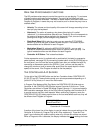
Your First Session: Chapter 2
Your QS is an expandable system using the two PCMCIA EXPANSION CARD slots
on the back panel. There are three different kinds of Sound Cards available through
your Alesis dealer or directly from Alesis:
• SRAM cards: The Alesis Virtual Composer card provides an additional four
banks of Program/Mix memory. All banks can be stored to by the user, and it
comes with additional Programs and Mixes pre-stored.
• QCards: These read-only memory cards provide actual samples, plus the
Programs and Mixes that use them in a single card bank. Available QCards
include a Stereo Grand Piano card, a Pop Rock card that includes high-quality
guitar, drum, bass, and keyboard sounds, a World/Ethnic card and a
Rap/Techno/Dance card.
• Flash RAM cards: If you want to burn your own custom sample cards, Flash
RAM cards are available in 2 MB, 4 MB, and 8MB sizes. Alesis Sound Bridge
software (see next section) will translate from Sample Cell format to Alesis QS
Composite Synthesis format, and then you can write your own custom Programs
and Mixes that use these samples.
To use a sound card with the QS:
¿ Hold the card with the front label facing up and insert the exposed contact end
gently into either of the QS’s PCMCIA EXPANSION CARD slots, [A] or [B].
¡ Push the card in until you the slot’s eject button extends outward, and the card
will not go any further.
¬ To remove the card, press the eject button adjacent to the card slot and gently
slide the card out of the slot.
The QS’s two PCMCIA EXPANSION CARD slots can accommodate any combination
of these three card types. You can combine QCards and Flash RAM cards that store
up to 8 MB of samples each, giving you a total of 16 Mb of sound ROM expansion
and effectively doubling the internal 16 MB of sound ROM for a total of 32MB!!
When storing Mix and Program Banks to external cards, the maximum number of
accessible card banks is 11. This is because the QS’s grand total of banks possible is
16, and 5 of them are already built into the QS. The 11 card banks can be split
among the two PCMCIA EXPANSION CARD slots. Under normal situations, this will
not be a limitation (remember, each bank has 128 Programs and 100 Mixes; 11
banks gives you 1408 additional Programs and 1100 additional Mixes).
In other words, if you have two SRAM cards (256k each, capable of storing up to 4
banks), you will have 4 banks available on each card for a total of 8 banks; well below
the maximum. However, since it is possible to purchase third-party 512k PCMCIA
cards and burn these yourself using Sound Bridge software, it is possible to
physically insert two 8 bank cards which combine for a total of 16 banks. In this
situation, only the first 11 banks will be accessible beginning with slot [A]; i.e. you’ll be
able to access all 8 banks from the card in slot [A] and the first 3 banks from the card
in slot [B].
QS7/QS8 Reference Manual 19


















